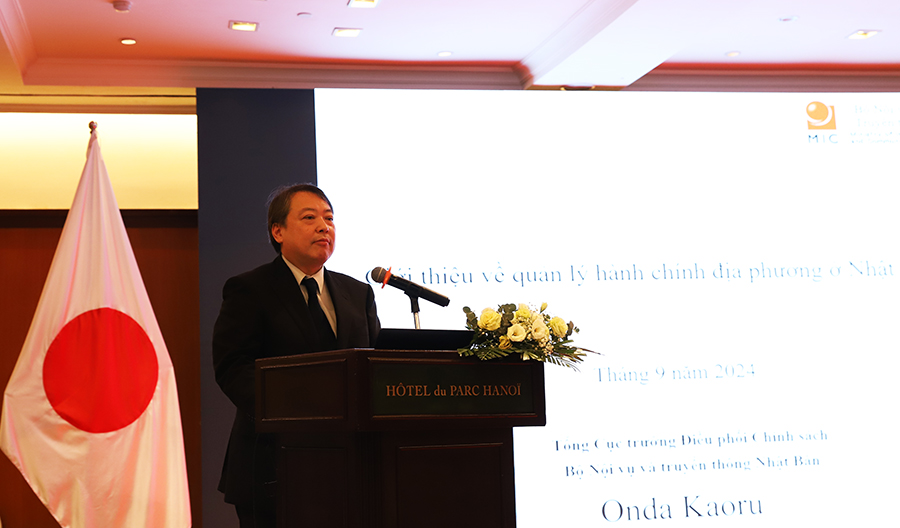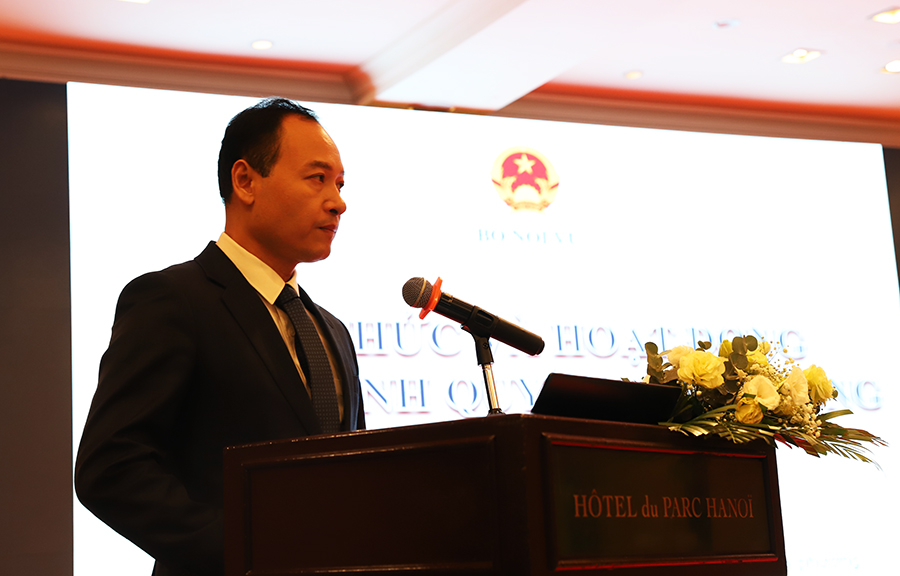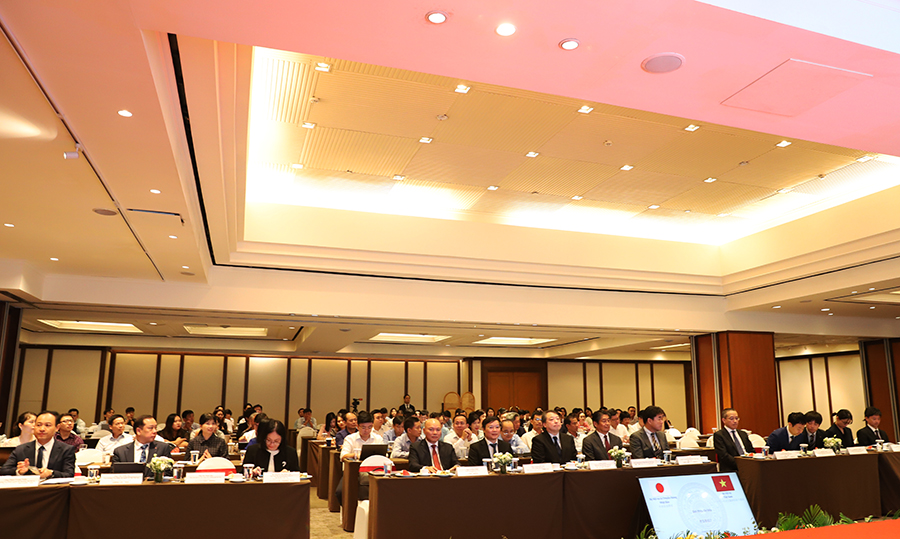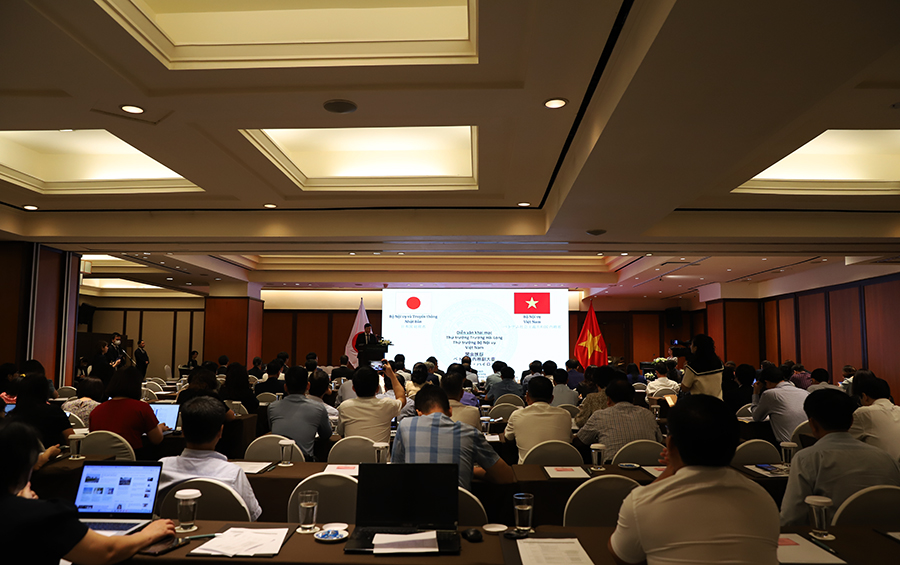During the morning session of the “Viet Nam-Japan Local Government 2024″ workshop, held on September 20, 2024, in Ha Noi, representatives from the Ministry of Home Affairs (MoHA) of Viet Nam and the Ministry of Internal Affairs and Communications (MIC) of Japan discussed the local government systems of the two countries.

Mr. Onda Kaoru, Director-General for Policy Coordination, MIC of Japan, delivering the presentation on “Overview of Japan’s Local Government System” at the workshop.
Local governments in Japan having significant responsibilities in handling administrative tasks
Opening the discussion, Mr. Onda Kaoru, Director-General for Policy Coordination, MIC of Japan, gave an overview of Japan’s local government system.
Japan has a total area of 378,000 km², a population of 125 million, and a population density of 345 people/km².
Summarizing Japan’s local government system, Mr. Onda Kaoru highlighted the following points:
(1) Local Autonomy: Local autonomy in Japan is protected by the Constitution, with both the central and local governments recognized as separate legal entities. The structure of local autonomy and the relationship between the central and local governments are regulated under the Local Autonomy Law.
(2) Two-Tier Local Government System: Japan has a two-tier system consisting of the prefecture-level (prefectures and centrally-run cities) and the municipal level (cities, towns, and villages). Japan is a unitary state, not a federal one, with 47 prefectures and 1,718 municipalities as of April 1, 2023.
(3) Local Government Councils: Local governments have councils with elected members chosen through direct elections. These councils have the authority to pass budgets and enact legislation within the scope of the law.
(4) Elected Leaders: Leaders such as governors and mayors are elected directly by the people and are responsible for managing local administration. The national administration is led by the Cabinet, and Japan follows a Cabinet and Parliamentary system. Administrative boards handle areas like education and police.
(5) Significant Administrative Responsibilities: Local governments in Japan are responsible for carrying out numerous administrative tasks and projects, handling around 70% of the administrative duties. They operate at a level comparable to state and local governments in a federal country.
Regarding the allocation of financial resources between central and local governments, Mr. Onda Kaoru explained that in Japan’s public finance system, the ratio of final spending between the central and local governments is the reverse of the tax burden allocation between them. There is a significant disparity between these two ratios.
To establish regional sovereignty, a thorough reconsideration of the division of roles between the central and local governments is necessary. Additionally, from the perspective of expanding financial resources that local governments can freely utilize, the method of tax resource allocation between the central and local levels needs to be reviewed.
For example, 63.7% of taxes collected from citizens are allocated to the national government, while only 36.6% is allocated to local governments. However, in terms of government spending (on a net expenditure basis), the central government accounts for 44.3%, while local governments account for 55.7%, with this spending aimed at providing services to the public.
Regarding the division of administrative duties between the central and local governments, most administrative tasks closely related to the lives of citizens are carried out by local governments. Local governments also bear the responsibility for addressing Japan’s internal political issues.
The relationship between the central government and local governments today is one of “cooperation and equality,” though it used to be a relationship of “management and subordination.” The background for the birth of the local decentralization reform includes (i) The overload of the centralized administrative system; (ii) The need to respond to a changing international society; (iii) Addressing the excessive concentration of resources and power in Tokyo; (iv) Creating rich, unique local communities; (v) Dealing with an aging society and declining birthrate. Since the establishment of the city, town, and village system in the 22nd year of the Meiji era (1889), these local entities have continuously merged and cooperated to strengthen the local administrative management system. This system is designed to handle population growth, economic development, and the increasingly complex demands of local governance resulting from decentralization.
Coordinating work to improve services and administrative management standards
To address the increasing complexity and specialization of administrative management needs and improve the efficiency of task handling, many local governments in Japan have coordinated their efforts. This coordination aims to enhance services and administrative standards while reducing management costs. Examples of this include jointly establishing agencies, delegating tasks, and partially merging responsibilities.
Cities of a certain size, along with neighboring towns and villages, have formed regional areas and divided responsibilities. These regions not only serve as “population reservoirs” but also create central hubs to maintain a dynamic society and economy nationwide.
Framework of reform using the proposal system:
Japan’s population trends have been facing a decline in recent years. By 2070, it is estimated that the total population will drop below 90 million, with an aging rate of 39%. The annual trends in births and total fertility rate (TFR) show a continuous decline since the second baby boom, and although the TFR increased slightly from 2006, it began decreasing again from 2016. Meanwhile, the number of deaths and the mortality rate have steadily risen in recent years.
Thus, Japan faces several challenges due to its declining population, falling birth rates, and aging society: (i) Delays in the development of new industries and the phasing out of old industries; (ii) Employment insecurity; (iii) Concerns about living in a society with declining birth rates and an aging population; (iv) Dissatisfaction due to a lack of fulfillment; (v) Increased responsibility and role in the global society.
Japan’s future direction
Efforts to address the challenges Japan faces include: building a free and dynamic economic society, creating a prosperous and secure economic environment, and participating actively in the global society.
The foundation to support a new economic society involves: developing a free and vibrant economy, ensuring prosperity and security, and global engagement. Additionally, Japan needs to focus on human resource development, fostering scientific and technological innovation, advancing information and communication technology, and promoting social capital development.
Regarding local government efforts in digital transformation, Japan’s key plans to realize a digital society aim to strengthen the digital industrial infrastructure, turn “digitization” into a norm, enhance sustainability through data linkage, complete and operate a shared digital infrastructure for both central and local governments, and increase international cooperation.
Promoting digital transformation in local government administration:
To standardize and popularize local government information systems, Japan passed the “Law on Standardization of local government information systems,” which requires local governments to use information systems that meet standardized requirements (standardized systems) for specific administrative tasks(*).
Japan aims to complete a smooth and secure transition to standardized systems using the “Government Cloud” by fiscal year 2025 (Reiwa 7). For systems where transitioning is considered extremely difficult, a necessary completion deadline will be set (Cabinet decision on September 8, 2023).
*The 20 standardized administrative areas include child benefits, child support and care, the basic resident registry, family registry annexes, seal registration, voter list management, fixed asset tax, individual resident tax, corporate resident tax, light vehicle tax, family registry, education, health management, child-rearing allowances, livelihood assistance, disability welfare, nursing care insurance, national health insurance, healthcare for the elderly (75+), and national pension insurance.
Expected effectiveness of unifying and standardizing core task systems
For the citizens, the infrastructure for online application submissions is unified across all local government agencies nationwide. Administrative services can be easily accessed 24 hours a day, 365 days a year, using the “My Number” Card.
For local governments, there is no longer a need to self-improve systems every time there is a change in regulations. Now, processes can be handled smoothly by selecting standardized applications on the “Government Cloud.”
Systems used nationwide (such as application management, etc.) will also be provided on the “Government Cloud” to further reduce costs and simplify the deployment of various administrative services.
The “My Number” Card: The future identity verification tool
Direct identity verification: Used as a photo ID for identity verification; Strict identity verification at local government offices – Proof of identity; Since it has a photo, impersonation is impossible; Identity can be verified in both public and personal sectors.
Electronic identity verification: Secure and confidential online identity verification.
With electronic certification, various procedures and contracts can be executed via smartphones and computers. Residents can obtain copies of residence certificates at convenience stores nationwide. It can be used to earn “Myna Points” or replace health insurance cards. Furthermore, in the future, it will realize the use of AI and many other advanced technologies.
Presenting “My Number”: Proof of “My Number” by presenting this card without needing to attach documents in social security, tax, and other procedures.
“Mynaportal” serves as the gateway connecting one’s life with administrative agencies, with the key being the “My Number” Card. It provides services such as online applications, viewing and retrieving personal information held by administrative agencies, and receiving notifications, among others.

Mr. Nguyen Anh Duong, Deputy Director-General of the Department of Local Government, MoHA, with the presentation titled “Overview of Viet Nam’s Local Government System.”
Administrative units of Viet Nam organized into three levels: province, district, commune
In the discussion regarding the organization and activities of local government in Viet Nam, Mr. Nguyen Anh Duong, Deputy Director-General of the Department of Local Government, MoHA, stated that administrative units in Viet Nam are organized into three levels: province, district, and commune. The provincial level includes provinces and centrally-governed cities; the district level includes districts, towns, provincial cities, urban districts, towns, and cities under centrally-governed cities; and the commune level includes communes, wards, and townships.
Regarding the organizational model of local government, the 2015 Law on Local Government Organization stipulates that all administrative units are structured to include both the People’s Council and the People’s Committee at the local government level.
As for the delineation of tasks and authority between central and local state agencies, as well as within each level of local government, the 2013 Constitution and the 2015 Law on Local Government Organization (amended and supplemented in 2019) specifically outline six principles of decentralization, transfer of power, and authorization between central and local state agencies and within each level of local government.
Regarding transfer of power: The law stipulates that the transfer of power to local government levels must be defined within legal statutes. Local governments operate autonomously and are responsible for carrying out the tasks and powers assigned to them. Higher-level state agencies are responsible for inspecting and reviewing the constitutionality and legality of the tasks and powers delegated to local government levels within the scope of their responsibilities. When laws specify the tasks and powers of local government and its agencies, they must ensure principles of jurisdiction delineation and align with the tasks and powers defined by the Law on Local Government Organization.
Regarding decentralization: The law provides that based on work requirements, implementation capacity, and specific conditions of the locality, both central and local state agencies have the authority to delegate to local governments or lower-level state agencies to continuously and regularly carry out one or more of their tasks and powers, unless otherwise stipulated by law. Decentralization must adhere to principles of jurisdiction delineation and be documented in regulatory legal documents from the delegating state agency, clearly defining the tasks and powers decentralized to local governments or lower-level state agencies, as well as the responsibilities of both the decentralizing agency and the decentralized agency.
When a higher-level state agency decentralizes tasks and powers to local governments or lower-level state agencies, it must ensure the necessary resources and conditions are provided for the execution of those decentralized tasks and powers; guide and inspect the implementation of the decentralized responsibilities, and be accountable for the outcomes of the tasks and powers it has decentralized.
The agency receiving the decentralization is responsible to the decentralizing agency for executing the decentralized tasks and powers. Depending on the specific situation in the locality, local state agencies may further decentralize to local governments or lower-level state agencies to carry out the tasks and powers that have been decentralized by the higher-level state agency, but this must be done with the approval of the decentralizing agency.
Regarding authorization: The law stipulates that in necessary cases, higher-level state administrative agencies may authorize in writing the local People’s Committees or other agencies and organizations to carry out one or more of their tasks and powers for a specified period, along with specific conditions.
When a higher-level state administrative agency authorizes a lower-level People’s Committee or another agency or organization, it must ensure the provision of necessary resources and other conditions required for the execution of the authorized tasks and powers; guide and inspect the implementation of the authorized responsibilities, and be accountable for the outcomes of the tasks and powers it has authorized.
The agency or organization receiving the authorization must accurately perform the content of the tasks and is responsible to the higher-level state administrative agency for the execution of the tasks and powers it has been authorized. The agency or organization receiving the delegation is not permitted to further authorize the tasks and powers that have been authorized by the higher-level state administrative agency to another agency or organization.
Additionally, the Law on Local Government Organization also specifies the organizational structure and operations of the People’s Council and the organizational structure and operations of the People’s Committee.
According to Mr. Nguyen Anh Duong, the Law on Local Government Organization of 2015 (amended and supplemented in 2019) has concretized the provisions of the 2013 Constitution regarding the organization of administrative units and the organization of local government, in accordance with the requirements for building and perfecting a socialist rule-of-law state for the people, by the people, and for the benefit of the people.
Decentralization and transfer of power remaining primarily “top-down” by level of government
However, during the process of organization and implementation, there are still several difficulties and obstacles, specifically:
(1) Decentralization and transfer of power are still mainly “top-down” according to government levels; they do not align with the position and role of each government level and the characteristics of different types of rural, urban, and island governments; they are not linked to administrative procedure reforms; the mechanisms for controlling power have not been fully developed in line with the requirements for enhancing decentralization and transfer of power.
(2) Some tasks and powers of the provincial, district, and communal People’s Councils are stipulated in the law but are not specific or clear, which can lead to varying interpretations in practice and result in inconsistency during implementation; certain tasks are carried out by both the provincial and district levels, or both the district and communal levels, but the authority and responsibilities of each level are not clearly defined.
(3) The position, role, responsibility, and activities of members of the People’s Committee as members of the Committee are not clearly outlined; the collective working regime of the People’s Committee combined with the responsibility of the Chairperson of the People’s Committee, if not implemented well, leads to excessive meetings, wasting time, unclear responsibilities for each member of the Committee, and delays in addressing urgent and necessary matters.
(4) In addition to implementing the urban government model in three cities (Ha Noi, Da Nang, Ho Chi Minh City), local governments in other administrative units are still at the local government level (with a People’s Council and a People’s Committee) and do not differentiate based on the characteristics of rural, urban, and island areas; the urban government model in these three cities has only recently been implemented.
(5) The number of administrative units with small land areas and low populations remains high, resulting in scattered investments and difficulties in organizing the apparatus and streamlining personnel at the local government levels.
Continuing to improve the mechanism of decentralization and transfer of power between government levels from central to local
At the workshop, Mr. Nguyen Anh Duong shared that the Ministry of Home Affairs is leading and coordinating with central ministries, agencies, and localities to conduct a review of the implementation of the Law on Local Government Organization of 2015 (amended and supplemented in 2019). This will serve as a basis for proposing comprehensive amendments and supplements to the current Law on Local Government Organization, which will be submitted to the Government in October 2024 for presentation to the National Assembly in 2025. Accordingly, several major directions for amending and supplementing the Law on Local Government Organization are as follows:
(1) Clarifying the position, role, function, and tasks of local governments: This involves clearly defining the tasks and powers within the authority of the central government and each level of local government, moving from the lower level to the upper level. If a lower-level local government cannot perform a task, then the upper-level local government or a central agency will take on that responsibility. Thus, each level is responsible for the tasks and powers assigned to it, while other levels will coordinate as necessary to avoid overlapping authority. There should be improved transparency in the operations of local governments and accountability among the various levels of local government, especially for those in leadership positions.
(2) Continuing to improve the mechanism of decentralization and transfer of power: This aims to emphasize the importance of autonomy and accountability, promoting initiative, creativity, and efficiency in the management activities of each level of local government. There should be diversity in organizational models and a streamlined structure for local government levels, clarifying job positions at each level to ensure reasonable labor distribution and personnel streamlining. Strengthening regional connectivity across the country and within each locality is also essential.
(3) Further improving the regulations on the establishment, dissolution, merging, division, adjustment of administrative boundaries, and arrangement of administrative units: This involves amending and supplementing legal regulations on the standards for administrative units, particularly those with specific characteristics. Based on this, efforts will be intensified to arrange district and commune-level administrative units that do not meet the established standards; concurrently, research will be initiated on the theoretical and practical basis for arranging provincial-level administrative units in Viet Nam historically to present to the competent authorities for consideration at the appropriate time.
(4) Innovating the organizational model of local governments: This involves adapting the model to suit rural, urban, island areas, and special administrative-economic units. The aim is to move towards urban local governments not having People’s Councils at the district and ward levels (in urban inner-city areas) and to study the experiences of other countries regarding the “City Hall” and “Mayor” models that are suitable for Vietnamese specific characteristics. Additionally, rural local governments will not have People’s Councils at the district level. Based on this, there will be a study on renaming the People’s Committee to the Administrative Committee in administrative units that do not have local government structures (without a People’s Council) to facilitate the organization of different local government models in administrative units with local government structures (which have both People’s Councils and People’s Committees) and in administrative units without local government structures (which only have an Administrative Committee performing the civil service duties assigned by the upper-level People’s Committee for administrative management in the territorial area).
(5) Reforming the activities of local governments: This will clarify the responsibilities of the heads and each member of the People’s Committee, where committee members will be the heads of specialized agencies under the People’s Committee, responsible for deciding on tasks within the authority of the People’s Committee as committee members to overcome the formal nature of the current roles of committee members. Specific and clear regulations will be established regarding the tasks, powers, and oversight processes of the People’s Council and its agencies, as well as the representatives of the People’s Council.
(6) Building e-government and digital government: This will involve developing a team of public officials that meet the requirements of the digital transformation tasks. There will be an increased application of information technology, the use of smart technology, and seamless connection and operation of management software to gradually expand the provision of various public services at the local level, simplify administrative procedures, accelerate task implementation, and save state budget and social costs.






